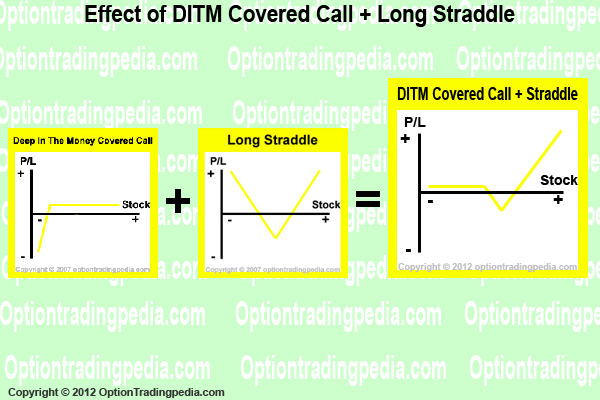
"Combining Covered Call with Straddle?"
"What are the pros & cons of writing a deep in the money covered call and then using the a proportion of the premium to buy an at the money straddle? If I am already long the underlying stock, this would seem to be a low risk way of protecting both upside opportunity and downside risk, assuming that I let the options run to expiry, get assigned on the DIM covered call and exercise either the put or the call depending on which way the underlying had moved to re-establish the long stock position. Would this work.. or am I missing something?"Asked By NMus on 19 March 2012
Answered by Mr. OppiE
Hi Nmus,
This is an extremely interesting combination options strategy indeed and I have to be honest with you that in all my years of trading options, this is the first time I actually looked into such a Deep In The Money Covered Call + Long Straddle combination. Honestly, I was surprised at the effects of such a combination myself and found it to be extremely interesting. Here's what I found...
First of all, financing the Long Straddle using proceeds from the Deep In The Money call options written effectively changes the Deep In The Money Covered Call from a neutral / bullish options strategy where you will make a loss only when the price of the underlying drops drastically, to a volatile options strategy where you will make a loss only if the price of the underlying stays relatively stagnant. Below are the risk graphs of both options trading strategies and the resultant options position:

As you can see from the risk graphs above, combining the Deep In The Money Covered Call with the Long Straddle gives you the properties of both options strategies, transforming it into a volatile options strategy where you will make an unlimited profit should the price of the underlying goes upwards and a fixed profit should the price of the underlying goes downwards.
Example of Combining Covered Call with StraddleAssuming AAPL is trading at $595 right now with its April $595 strike price call options asking for $25 and its April $595 strike price put options asking for $25 and its April $550 strike price call options bidding for $55.Scenario 1: AAPL rallies to $610 AAPL's product announcement went well and stock price rallies to $610 by expiration of the April options. Loss from $550 strike price call options = $610 - $550 = $60 - $55 = $5 Profit from $595 strike price put options = $25 Net profit = ($15 + $25) - ($5 + $10) = $40 - $15 = $25 Scenario 1: AAPL drops to $580 AAPL's product announcement went sour and stock price tanks to $580 by expiration of the April options. Loss from shares = $595 - $580 = $15 Profit from $550 strike price call options = $580 - $550 = $30 - $55 = $25 Profit from $595 strike price call options = $25 Loss from $595 strike price put options = $595 - $580 = $15 - $25 = $10 Net profit = ($25 + $25) - ($15 + $10) = $50 - $25 = $25 |
As you can see above, having such a position in place not only made sure you continue to profit should the price of the underlying stock rallies but it actually increases its profits! In the example above, you would have made only $15 profit if you had held only AAPL shares instead of $25 profit with this options trading strategy in place. Not to mention the fact that you won't have made that $25 profit if the price of AAPL drops instead of rises. But what is the drawback of this approach? The drawback is that if the price of AAPL remains stagnant, you would have made a loss in the order of the expired long straddle less the extrinsic value of the deep in the money call options.
Maximum Loss Example of Combining Covered Call with StraddleMaximum loss = Maximum loss of straddle - extrinsic value of short DITM callMaximum loss = ($25 + $25) - ($55 - $595 - $550) = $50 - $10 = $40 x 100 = $4000 |
The overall delta of the position would also be inclined to be positive, as such, the position would tend to make a profit if the price of AAPL goes up and make a loss if the price goes down with significant time left to expiration. Also, the theta of the position is negative. This means that time decay works against the position and the position will lose value over time due to time decay of all three long options legs if the price of the underlying stock remains stagnant. As such, when it is clear that the price of the stock is going to remain stagnant and there is still significant time to expiration, it is advisable for you to close out the long straddle and just hold on to the Deep In The Money Covered Call in order to prevent a loss.
In conclusion, financing a long straddle using proceeds from the Deep In The Money Covered Call is a very clever options trading strateby combination which takes no additional money to put on and transforms a stock position into a volatile position. However, you need to take note of the fact that a loss will occur if the price of the underlying stock remains relatively stagnant, even if you eventually allow your stocks to be assigned.
Important Disclaimer : Options involve risk and are not suitable for all investors. Data and information is provided for informational purposes only, and is not intended for trading purposes. Neither www.optiontradingpedia.com, mastersoequity.com nor any of its data or content providers shall be liable for any errors, omissions, or delays in the content, or for any actions taken in reliance thereon. Data is deemed accurate but is not warranted or guaranteed. optiontradinpedia.com and mastersoequity.com are not a registered broker-dealer and does not endorse or recommend the services of any brokerage company. The brokerage company you select is solely responsible for its services to you. By accessing, viewing, or using this site in any way, you agree to be bound by the above conditions and disclaimers found on this site.
Copyright Warning : All contents and information presented here in www.optiontradingpedia.com are property of www.Optiontradingpedia.com and are not to be copied, redistributed or downloaded in any ways unless in accordance with our quoting policy. We have a comprehensive system to detect plagiarism and will take legal action against any individuals, websites or companies involved. We Take Our Copyright VERY Seriously!
Site Authored by